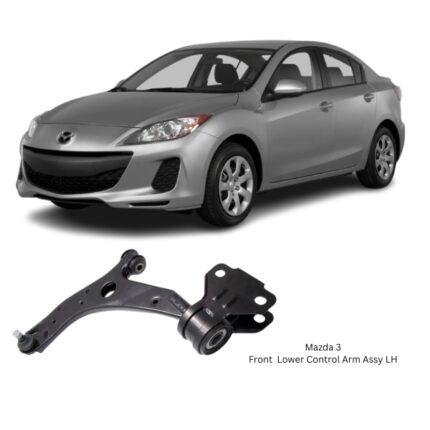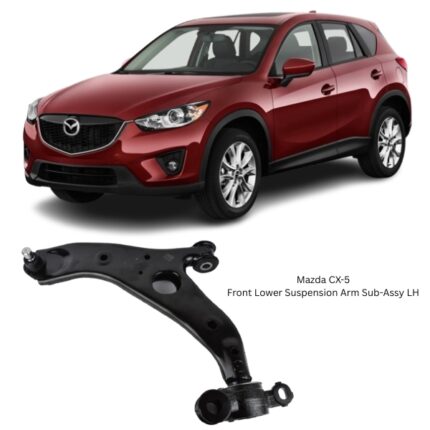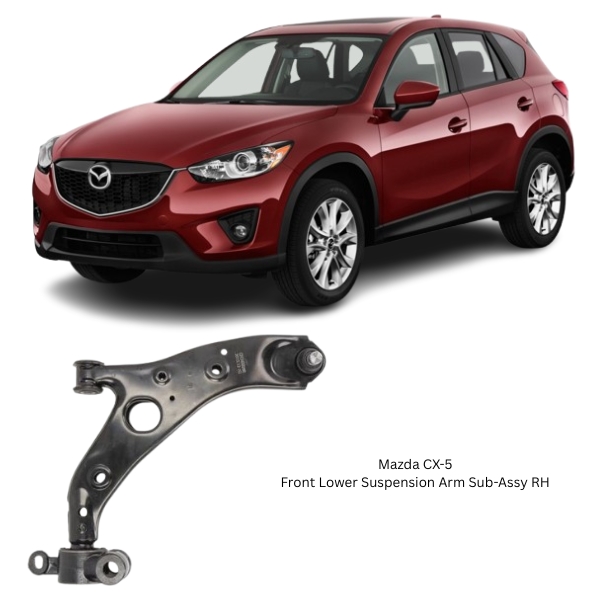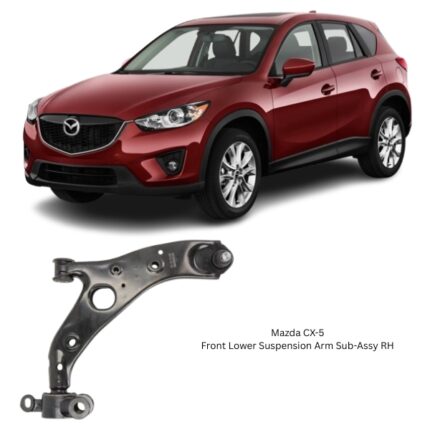Get Mazda CX-5 Front Lower Control Arm Assy RH KD35-34-300H in Kenya
The Front Lower Control Arm Assembly RH (Right-Hand) is an essential part of the front suspension system in a vehicle. Its main responsibility is to link the vehicle’s frame or subframe to the wheel assembly, particularly the right-hand front wheel. Through its connection points, bushings, and ball joint, the lower control arm plays a pivotal role in wheel positioning, steering control, and ride quality. It helps maintain consistent wheel alignment, ensures maximum tire contact with the road surface, and supports the overall dynamics of steering and suspension systems.
Made from high-strength materials and engineered for durability, this component is crucial in ensuring safe, stable, and responsive driving under a variety of road conditions. Whether navigating city roads, sharp bends, or uneven terrain, the Front Lower Control Arm Assembly RH is vital for maintaining comfort, control, and structural stability.
Component Structure and Materials
The construction of the Front Lower Control Arm Assembly RH typically includes:
-
Arm Body: Made from stamped steel, forged aluminum, or cast iron, selected for its strength and ability to withstand continuous stress and load-bearing over long periods. The arm’s design often follows an A-shape or L-shape geometry, optimized for strength and movement.
-
Bushings: High-quality rubber or polyurethane bushings are inserted at both ends where the arm connects to the subframe. These bushings absorb shocks and allow for controlled flexing without compromising stability.
-
Ball Joint: A crucial pivot point that connects the control arm to the steering knuckle. It allows for smooth vertical movement of the wheel and also contributes to steering rotation.
-
Protective Coatings: A corrosion-resistant coating or powder finish is typically applied to the arm to protect against rust and environmental wear, particularly from road salt, debris, and moisture.
Each of these elements works in harmony to ensure long-term performance and reliability.
Functionality in Suspension System
The Front Lower Control Arm Assembly RH serves several core functions:
-
Connects Frame to Wheel Assembly: It forms the physical and mechanical link between the vehicle’s frame and the wheel hub assembly, allowing the wheel to move in a controlled arc during suspension travel.
-
Supports Steering Geometry: Maintains camber and caster angles essential to proper steering and handling.
-
Manages Vertical Motion: Controls the up-and-down motion of the wheel when the vehicle encounters bumps or dips, while minimizing lateral and forward/backward movement.
-
Distributes Forces: Transfers road loads from the wheel to the vehicle’s chassis evenly, improving control and reducing stress on other suspension parts.
-
Absorbs Vibrations: Through bushings and ball joints, it reduces vibrations transmitted from the road to the cabin, contributing to ride comfort and vehicle quietness.
Benefits of a High-Quality Lower Control Arm RH
Investing in a premium-quality Front Lower Control Arm Assembly RH offers numerous advantages, including:
-
Improved Steering Control: Helps maintain consistent steering alignment and feedback, especially during sharp turns or emergency maneuvers.
-
Enhanced Ride Comfort: Damps out vibrations and road shocks, ensuring a smooth ride.
-
Reduced Tire Wear: Maintains correct wheel alignment, minimizing irregular or premature tire wear.
-
System Integrity: Protects related components such as struts, shocks, stabilizer links, and tie rods by keeping suspension geometry within specification.
-
Extended Suspension Life: Reduces stress and wear on other suspension parts through even load distribution.
-
Increased Safety: Prevents unpredictable wheel movement or alignment shifts that could compromise braking or steering during operation.
Signs of Wear or Failure
Over time and with continued use, the Front Lower Control Arm Assembly RH may show signs of wear. Early detection and timely replacement are important to prevent further damage or unsafe driving conditions. Common symptoms of a failing control arm include:
-
Clunking or Knocking Sounds: Especially when driving over speed bumps, potholes, or making sharp turns. Often caused by worn bushings or a loose ball joint.
-
Poor Steering Response: A noticeable delay or looseness in the steering wheel may signal a problem in the control arm’s connection points.
-
Uneven or Excessive Tire Wear: Indicates misalignment due to a damaged or bent control arm.
-
Vehicle Pulling to One Side: A compromised suspension geometry may cause the vehicle to drift even on straight roads.
-
Vibrations in Steering Wheel: Caused by loose or damaged joints within the control arm assembly.
-
Visual Damage: Cracks, bends, rust, or torn bushings can often be seen during an inspection.
Any of these signs should be addressed promptly to maintain safe and efficient suspension performance.
Installation Overview
The installation of the Front Lower Control Arm Assembly RH requires mechanical skill and appropriate tools. It is recommended to have the installation carried out by a professional or experienced technician to ensure safety and proper alignment. The general steps include:
-
Lift the Vehicle: Use a hydraulic jack and support the vehicle with jack stands to ensure safe working conditions.
-
Remove Wheel: Detach the front right wheel to access the suspension.
-
Disconnect the Ball Joint: Use a ball joint separator or appropriate tools to disconnect the joint from the knuckle.
-
Unbolt the Control Arm: Remove the mounting bolts securing the arm to the frame and crossmember.
-
Install New Arm: Position the new assembly into place, aligning it with the mounting points.
-
Tighten to Torque Specifications: Use a torque wrench to ensure bolts are tightened to manufacturer-recommended levels.
-
Reinstall Wheel and Lower Vehicle.
-
Perform Wheel Alignment: A professional alignment should follow every control arm replacement to restore correct suspension geometry.
Maintenance Recommendations
While the Front Lower Control Arm Assembly RH is a wear-resistant component, good maintenance practices can extend its service life:
-
Visual Inspections: Check the bushings and ball joint for signs of cracking, deterioration, or looseness during routine servicing.
-
Clean Undercarriage: Keep the suspension area free of debris and salt buildup to avoid premature corrosion.
-
Avoid Harsh Driving Conditions: Limit high-speed impacts with potholes or curbs that can deform or crack suspension components.
-
Monitor Alignment: Regularly check wheel alignment, especially after impacts or suspension service.
Compatibility and Fitment Precision
Correct fitment of the Front Lower Control Arm Assembly RH is crucial. It must match the vehicle’s suspension layout and side orientation (right-hand side). Precision manufacturing ensures that:
-
Bolt holes align with factory mounts
-
Bushing and ball joint positions match OEM geometry
-
Suspension travel remains within factory-spec tolerances
-
No modification is required during installation
Improper fitment can lead to increased wear on other components, steering irregularities, or failure to pass wheel alignment.
Follow us on Facebook for more parts.





Reviews
Clear filtersThere are no reviews yet.